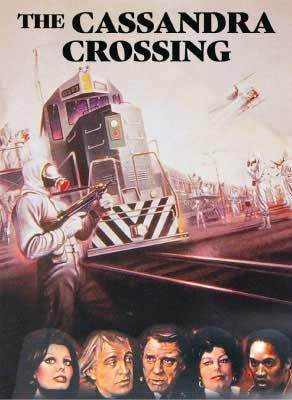Reply To:
Name - Reply Comment
The present COVID-19 pandemic affecting Sri Lanka among other countries draws parallels with the disaster thriller made in 1976 titled ‘The Cassandra Crossing.’
What’s intriguing is that both the present plague and the condition that affected commuters in the train, featured in the George Pan Cosmatos directed film, deal with a condition called pneumonia. And like present efforts by world medics underscoring the need for a quarantine process, this is what helps save those not affected by the disease in the film.

Sri Lanka is in the process of experiencing a total and partial shutdown in some districts. Only television channels function without a handicap from the perspective of mass communication. These electronic media outlets screen films these days to entertain viewers stranded at home due to State-imposed curfew. They should seriously consider screening the aforementioned film as it would serve the purpose of educating the public on the importance of quarantine during a plague.
Another similarity among the film and local authorities calling the shots during the present crisis is that most of the decisions are taken by the military or people with a military background. We can see that there is some hope and control of the situation as quarantine camps are administered by the army under the supervision of President Gotabaya Rajapaksa who is also an
ex-military officer.
The military is trained to be ruthlessly efficient. It shows in most parts of the film and how Sri Lanka is dealing with the pandemic which has affected over 100 individuals but failed to kill even one.
When individuals are labelled as those who must go into quarantine, they must adopt the mentality of being in the army. Inside the army discipline is the key. People of this nation need to be disciplined and some of those who didn’t learn it when times were good had to learn it during a quarantine process when death was staring in their faces.
Unlike in the present situation, there is a terrorist in a train who is affected by the virus. Much of the film from the start features dialogues between US military officials Elena Stradner and Col. Stephen Mackenzie. Stradner wants the train to be stationed so that the terrorist can be removed and quarantined. But Col. Mackenzie believes all passengers could be infected; hence his intention to make the train travel on to a disused railway line which leads to an ex-Nazi concentration camp. He wants all commuters to be quarantined there.
They say drama adds spice to tragedy. The US military in the film suspects ‘the stain’ could be a biological weapon. The plague has a mortality rate of 60%. The train is sealed with an enclosed oxygen system after the infected terrorist dies. His remains are in a hermetically-sealed coffin. Actually, only a few are infected and a small number of commuters die.
But in a situation like this, it is not only the military who act. Jonathan Chambertain (a neurologist) and Haley (an Interpol agent) seize control of the train and manage to separate the rear half of the train transporting passengers who aren’t affected by the plague. The front half of the carriages carrying those who contracted the illness enters the rickety old bridge making the structure collapse; all those in this section perish.
Those who survive the challenging journey in a way were those who were quarantined. Back to Sri Lanka and COVID-19, the quarantine process will work only if people understand that ‘nothing can be left to chance’ during a pandemic of this magnitude.
Both in drama and film, the script is penned to ensure good triumphs over evil. But in real life, COVID-19 doesn’t pick on the bad and set free the good people. It picks on those who don’t quarantine themselves to bring death to the doorstep.